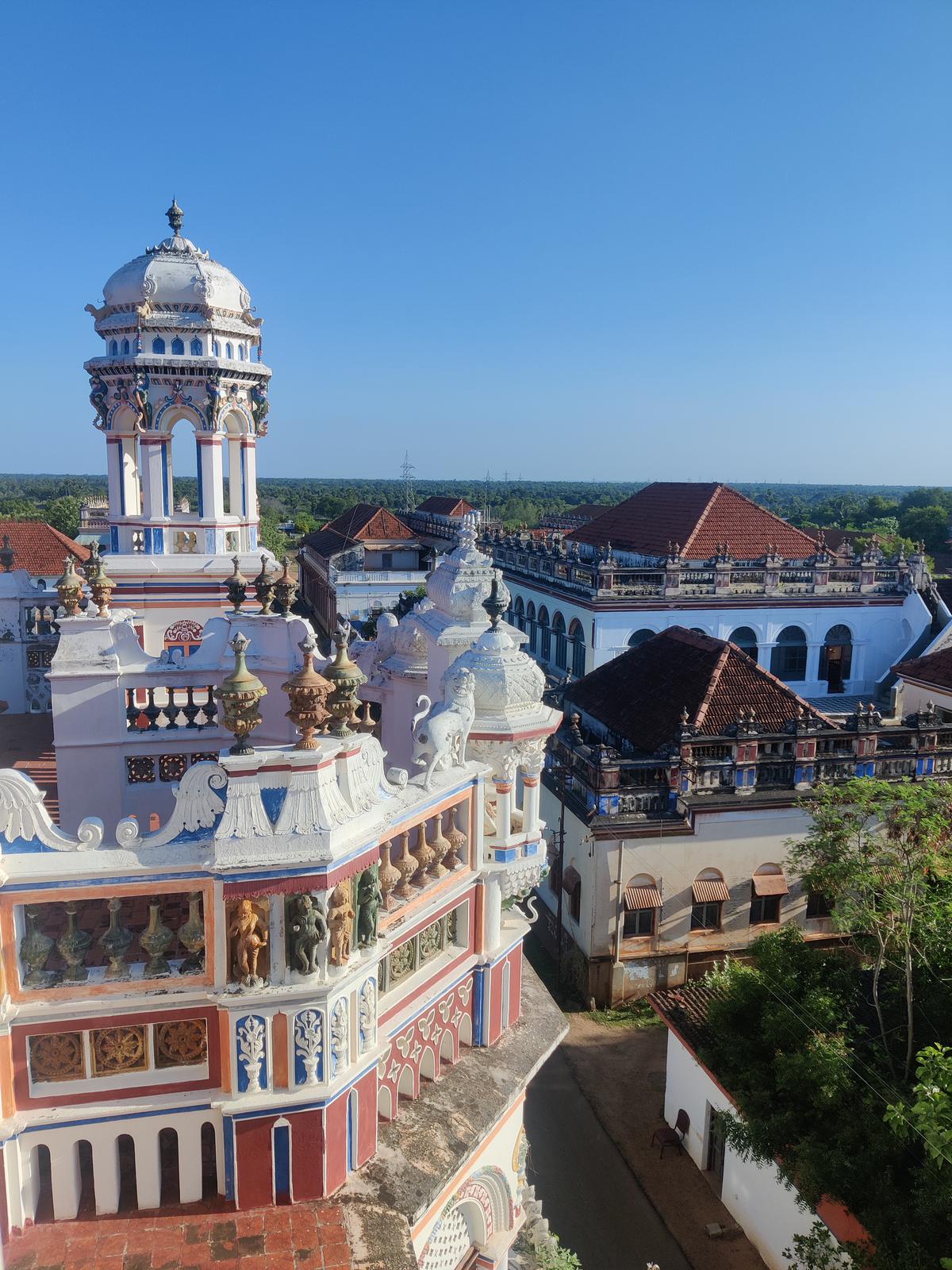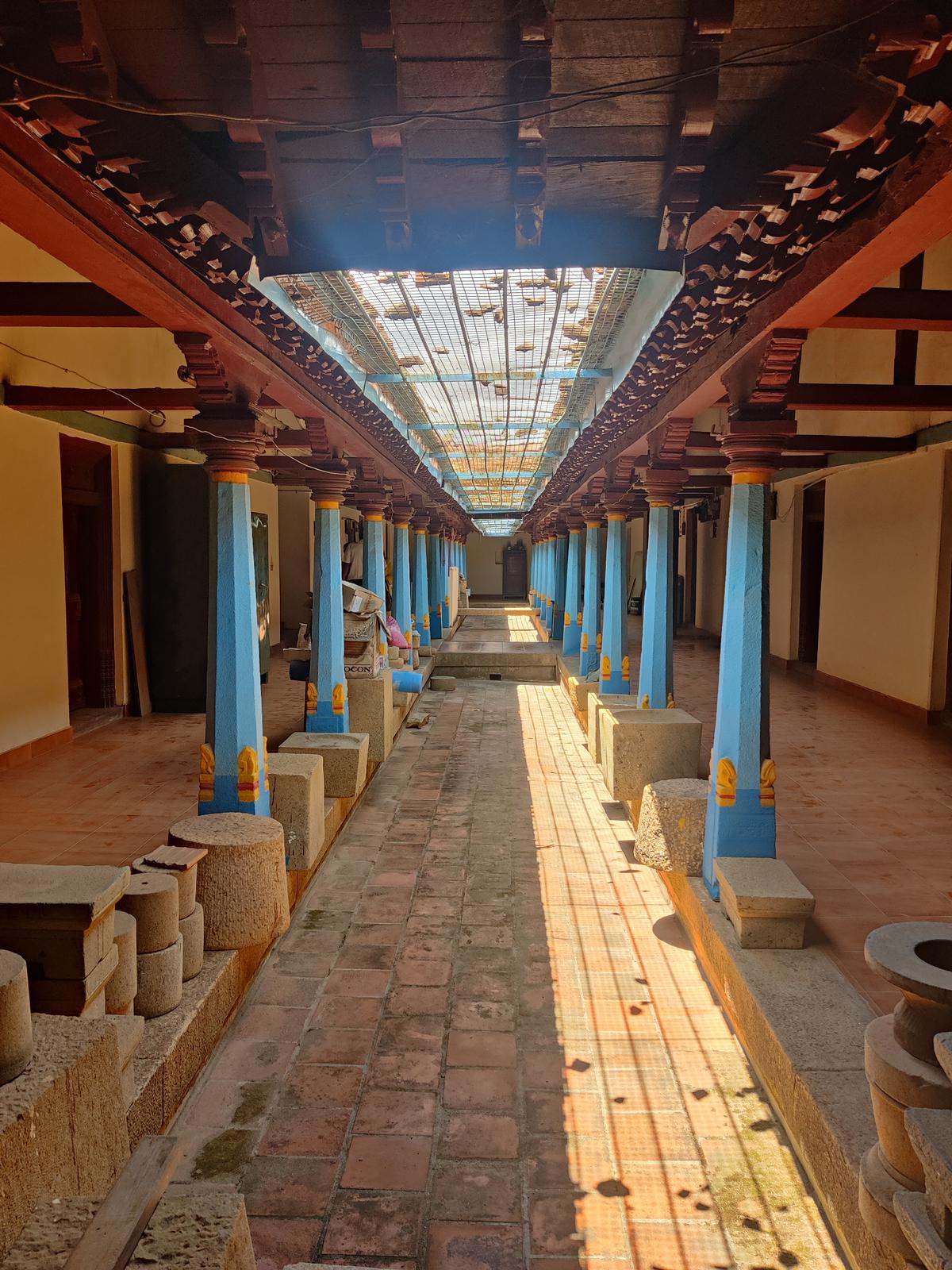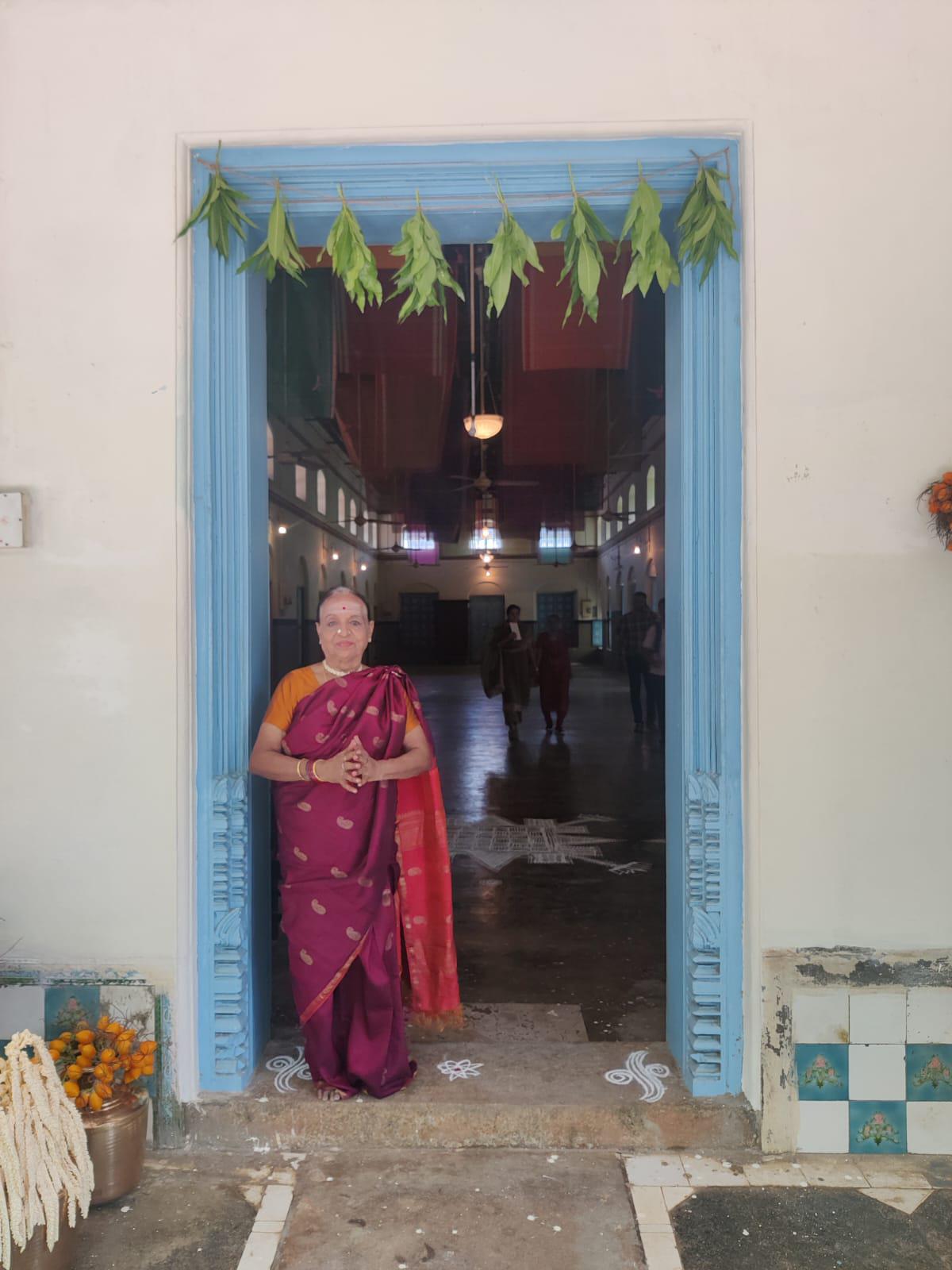Exploring century-old homes, and attending intimate concerts at Chettinad Festival
Chettinad is a fever dream. On its sun-baked arid landscape, punctuated by cacti and laced with palm trees, majestic century-old mansions rise like castles in a children’s tale.
Set in quiet villages, and springing up on narrow dusty roads, these ornate structures shimmer like mirages in the unrelenting heat. Their cavernous rooms, divided by pleasingly symmetric Burma teak pillars and lit by Belgian chandeliers, are cool with Italian marble floors and speckled with sunshine that spills through stained glass windows.

Chidambara Vilas and a series of mansions at the village of Kadiapatti
| Photo Credit:
Shonali Muthalaly
Spread across the Sivaganga and Pudokottai districts, the region, which comprises 76 villages, is a relatively undiscovered gem on the tourist circuit. The Chettinad Heritage And Cultural Festival aims to change this, albeit deliberately slowly and sensitively.
Hence the recently concluded 2nd edition, helmed by the community and limited to about 112 participants, focussed on giving guests a nuanced understanding of the Nattukottai Chettiars, their traditions and customs.
The 9th century Vijayalaya Choleeswaram Kovil
| Photo Credit:
R Rajapandiyan
The four-day festival opened under a fortuitous full moon at the Meenakshi Sundareswarar Sivan Kovil, Kanadukathan with an energetic percussion concert. Krishna Meyyammai, the moderator, explained why this festival was unique since it welcomed participants into their homes, and into their fold: “We want to introduce you to our way of life, food, art forms, customs, traditions, beliefs and values. It is our culture that links the past, present, and future. And you are keeping it alive… Because to understand our culture is to understand our heritage.”
Over the next three days, the event invited visitors to explore about 10 mansions, many opened up by the families to outsiders for the first time. About 11,000 of these incredible structures stand today, half of what existed about 50 years ago. Mostly built in the 19th Century by the mercantile Chettiar community, who travelled and worked all over South-East Asia, they are an exuberant, imaginative fusion of Indian and Western architectural styles, festooned with elaborate fittings from all over the world.

Inside Pothiyan Veedu in Karaikudi
| Photo Credit:
Shonali Muthalaly
Standing in a breezy open courtyard at Pothiyan Veedu, one of the older mansions, in Karaikudi, architect Kamalahasan Ramaswamy explained how these homes were built like “horizontal apartments” for large and growing joint families to live in. However, as the close-knit community began to relocate from the region, moving to cities across India and the world to work, the now-empty mansions became expensive to maintain and started being torn down, their valuable contents sold in antique markets.
“As much as making people aware that such a region exists, we also need to emphasise the need to protect its heritage and culture, because that is the only way it will survive,” says Bharatanatyam artiste Leela Samson, the curator of the festival. She adds, “The mansions are absolutely gorgeous, and the people who own them are very special — they are very proud, and very upright. They’re reticent. They’re modern and yet traditional…”
At the opening ceremony of the Chettinad heritage and cultural festival
| Photo Credit:
R Rajapandiyan
Hence, she says the festival is deliberately “humble.” “It is not ostentatious. I think it is mellow, sensitive, and intellectual… When you talk of culture and heritage, a nuanced presentation is what is beautiful. Loud culture is not for a place like this.”
Her programming therefore featured small concerts and talks in the halls and courtyards of the mansions, which turned out to be enchanting venues in the evenings, as the chandeliers came on, lighting up magnificent painted wooden roofs, lustrous walls, and rows of smooth marble pillars. The homes turned into stages for Bharatanatyam, a Carnatic vocal performance, and talks starring author Manu Pillai and historian Sam Dalrymple.
A skit on passing on values and heritage in a lullaby
| Photo Credit:
R Rajapandiyan
During the day, there were visits to temples led by architectural research scholar Madhusudhan Kalaichelvan, including the ancient Avudaiyar Kovil, Aranthangi’s Ayyanar temple vibrant with painted terracotta horses and a trek up a steep rock to the 9th Century Vijayalaya Choleeswaram Kovil. Discussing how most domestic tourism is spiritual tourism, Madhusudhan says the area is especially interesting since “You can see 1,500 years of temple construction here — from cave temples to the temples of the Cholas and Pandyas, to the Chettiar temples of the 20th Century.”
Of course, food is a large part of Chettinad’s charm and elaborate lunches were served on banana leaves every day at The Bangala, run by the indomitable Meenakshi Meyyapan, who stayed behind the scenes but is one of the main driving forces behind the festival.
At The Bangala, over tall glasses of fresh lime soda, her son, M Meyyappan explains how they were the first to consciously create tourism in the area when The Bangala launched in 1999. Decades later, there are still just a handful of luxury hotels in Chettinad, though the festival is acting as a catalyst, prompting more hoteliers to appreciate the region’s potential and its mansions.
A culinary workshop by Rakesh Raghunathan in progress at The Bangala
| Photo Credit:
R Rajapandiyan
“In the beginning, people stayed for a day or two. Then we started getting culinary tourists, especially the Japanese,” says Meyyappan. For a good reason: Meals at The Bangala featured about 22 items every day, featuring a parade of traditional vegetable preparations like banana flower curry, pineapple pachadi, and keerai masiyal, served with freshly fried fish, quail pepper masala, and mutton chukka. In the afternoons, food historian Rakesh Raghunathan taught guests how to cook dishes like traditional mandi and mutton uppu kari.
Yacob George, general manager of The Bangala and a core organiser of the festival, adds that the event has had a tangible impact with two to three new properties coming up already, and more locals considering restoring at least a part of the mansions and opening them as home stays.
“There is a dialogue that has started,” says Yacob, adding that the community has been very involved in the event. “One of our aims was to sow the seed. It should be an independent festival of the community eventually.”
Terracotta horses at the Ayyanar temple of Aranthangi
| Photo Credit:
R Rajapandiyan
As the event drew to a close with a flute concert at Meenakshi Meyyappan’s home, Meyyappan stood up to thank the guests. “Chettinad is a remarkable story starting in the early 1800s,” he says, “We were a small community that ventured overseas to do business… With those profits, we made mansions in a style and scale not seen anywhere. A bit extreme perhaps. But in my view it’s the extremes of the past that make the attractions of the future.”
He added that after Independence, “the glory began to fade and mansions began to crumble. A possible partial solution is to generate visitors. To help sustain the buildings. And trigger more preservation by the community. This is the reason for our effort to bring visitors from far and wide to Chettinad. There is an urgent need to create awareness…. “

At SA House in Kanadukathan
| Photo Credit:
Shonali Muthalaly
Meyappan concluded with a smile: “Spread the good word around about this strange place called Chettinad. It means a lot to us.”
The writer was in Chettinad at the invitation of The Chettinad Heritage & Cultural Festival
For all the latest Life Style News Click Here
For the latest news and updates, follow us on Google News.
